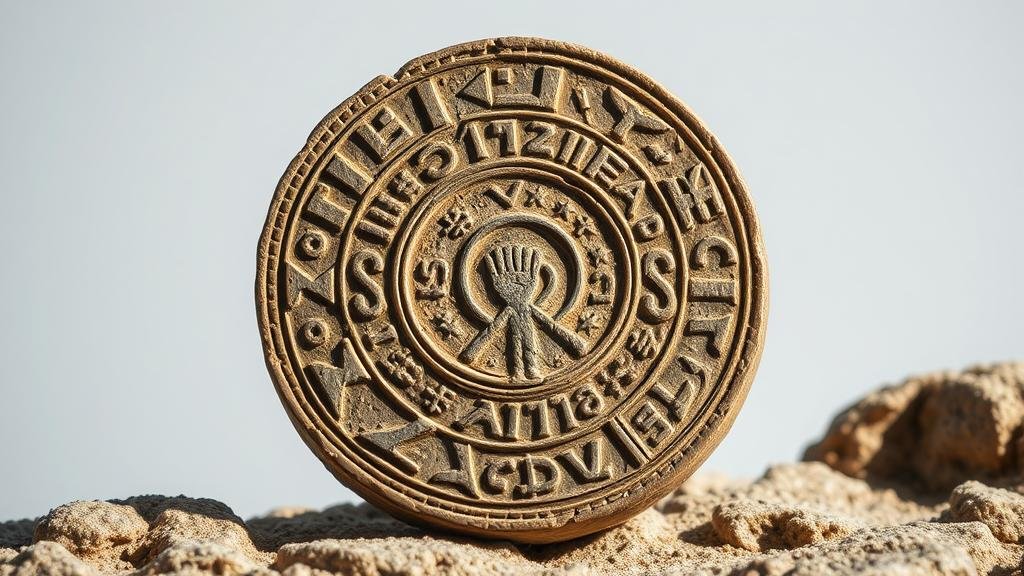Searching for the history of the “Phaistos Disc” and its undeciphered symbols.
The Mysterious Phaistos Disc: An Exploration of Its History and Symbols
The Phaistos Disc, discovered in 1908 in the Minoan palace of Phaistos on the island of Crete, has captivated historians and archaeologists due to its unique symbols and undeciphered script. This ancient artifact, dating to around 1700 BCE, stands as one of the most intriguing enigmas of archeology. In this article, we will explore the history of the Phaistos Disc, delve into its undeciphered symbols, and discuss the significance of this mysterious object in the context of ancient civilizations.
Discovery of the Phaistos Disc
The Phaistos Disc was unearthed by Italian archaeologist Luigi Pernier during excavations at the Minoan palace site on Crete. Measuring approximately 15 cm (5.9 in) in diameter, the disc is made of fired clay and is inscribed with a series of symbols on both sides. The disc features 241 individual symbols, comprising pictograms, ideograms, and abstract glyphs.
Perniers discovery occurred in Layer III of the Phaistos palace, a stratigraphy that dates back to the Late Minoan period. The area had been subject to destruction, likely due to earthquakes around 1700 BCE, which led to the abandonment of the palace. This timing places the disc squarely within the historical context of the Minoan civilization, renowned for its art, architecture, and significance in the Aegean region.
The Symbols of the Phaistos Disc
The most compelling aspect of the Phaistos Disc is the set of symbols inscribed on its surface. Comprising 45 distinct signs, these symbols have not yet been conclusively deciphered, leading to multiple hypotheses regarding their meaning and purpose.
Some of the notable attributes of the Phaistos Discs symbols include:
- A mix of human figures, animals, plants, and objects.
- Some symbols closely resemble those found in other Cretan writing systems, such as Linear A.
- The overall arrangement appears to follow a specific pattern, yet no universal consensus exists about its syntax or grammar.
Debates and Theories Around Decipherment
The undeciphered nature of the Phaistos Disc has led to numerous theories regarding its purpose. Some of the main hypotheses include:
- Religious or Ritual Use: One prominent theory suggests the disc may have been used in religious ceremonies or rituals, serving a symbolic or communicative function.
- Calendar or Chronological Tool: Some scholars propose that the symbols might represent a form of calendar, with signs correlating to lunar or solar cycles.
- Commercial or Administrative Record: Another possibility is that the disc was used as a form of record-keeping, potentially for trade or inventory purposes.
Despite various attempts at decipherment, efforts have largely been met with challenges. Notably, the absence of a Rosetta Stone-like artifact analogous to the Phaistos Disc hampers direct translation efforts. Astronomer Richard W. H. Burgess even proposed that the symbols are ideographic, representing concepts instead of sounds within a spoken language.
Significance in Minoan Culture
The Phaistos Disc represents more than just an artifact; it is a window into Minoan civilization and its cultural achievements. The Minoans are often credited with pioneering advances in art and architecture, evidenced by the construction of palatial complexes such as Knossos and Phaistos. The disc may be indicative of a complex communication system, signaling a sophisticated society that valued literacy and record-keeping.
Also, the ongoing efforts to decipher the Phaistos Disc shed light on the intersection of archaeology and linguistics, highlighting the broader challenges associated with understanding ancient civilizations that have left behind limited textual evidence.
Real-World Applications and Takeaways
The Phaistos Disc teaches us about the enduring mysteries of the past, emphasizing the importance of ongoing archaeological research. Modern technology, such as computer-assisted analysis and machine learning, could offer new avenues for deciphering ancient scripts, including the symbols on the Phaistos Disc.
As researchers continue to study the disc, the implications extend beyond mere historical curiosity; they enhance our understanding of communication, culture, and the evolution of writing systems. The Phaistos Disc remains a poignant reminder of the enigmas that history continues to offer, beckoning us to further explore the depths of human civilization.
To wrap up, while the meanings behind the symbols of the Phaistos Disc remain elusive, its historical significance is firmly established. The quest for understanding the art and culture of ancient Minoans mirrors humanity’s unending desire to connect with the past and our place within it.


